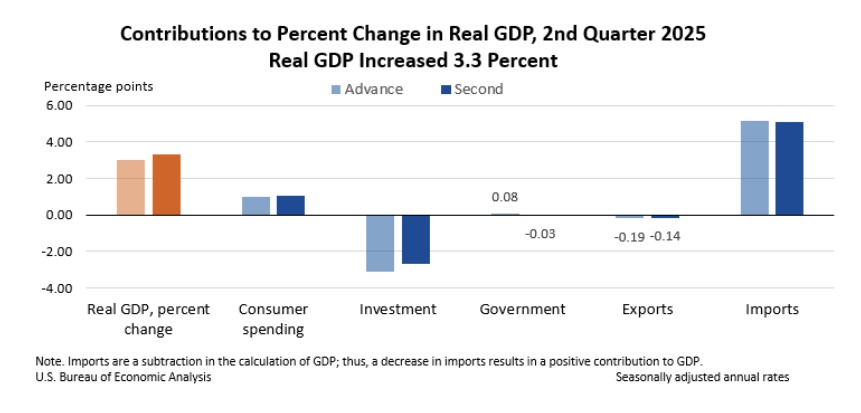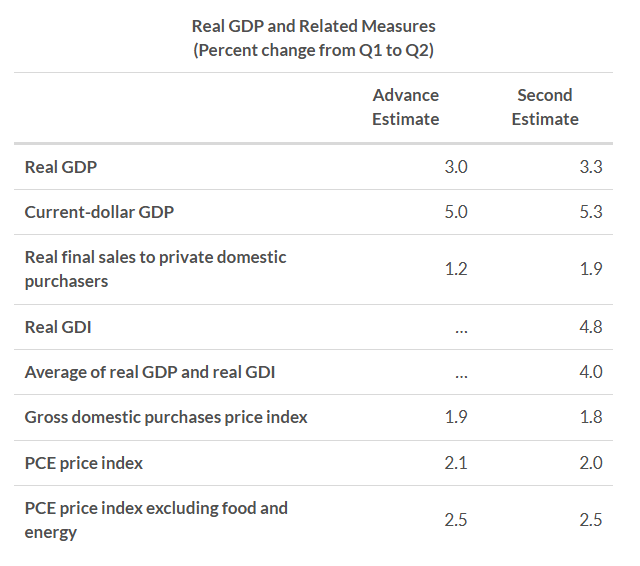US GDP growth for Q1 2025 was reported this morning, and the report was worse than expected. The first quarter contraction in 2025 is the first negative quarter of GDP growth since Q1 2022. What was expected was a report that was heavily skewed by trade data as net exports was the sole reason for the decline in GDP.
GDP Growth
-1.png)
US GDP saw a slight decline in Q1 2025, falling at a -0.3% seasonally adjusted annual rate (SAAR), which was worse than the consensus expectations of an increase at a slight 0.3% SAAR. Not only is this the weakest quarterly growth rate in three years, but it is also the first contraction since the -1.0% SAAR decline in Q1 2022. On a more positive note, the advance estimate was ahead of the Atlanta Fed’s GDPNow nowcast for Q1 2025 growth of -2.7% (last updated on April 29th, 2025) and also ahead of the gold-adjusted nowcast of -1.5%. For those who were following the whipsaws in the nowcast, the BEA’s GDP report might be somewhat of a positive surprise.
-2.png)
The key segment dragging down GDP growth in the first quarter was the net exports component. A large increase in imports (41.3% SAAR) in Q1 offset a smaller gain in exports (1.8% SAAR), which resulted in a -4.83 ppts contribution from net exports to headline GDP growth. This was the largest negative contribution from net exports since GDP records began in 1947. This is not really a surprise as it is consistent with the Atlanta Fed’s nowcast of the net exports component, and it reflects the effect of companies pulling forward imports to a massive degree ahead of the implementation of Trump’s tariff policies.
-3.png)
The large increase in imports also led to an increase in inventories that partially offset the negative net exports contribution. In Q1 2025, the contribution from private inventories was 2.25 ppts, the largest since firms built up inventories during the COVID supply chain crunch. When excluding both the net exports and the inventory component, GDP growth comes out to around 2.3% as a result of an increase in consumption and investment. This number is consistent with the growth in final sales to domestic purchasers, which grew at a 2.3% SAAR, and reflects solid domestic demand in the first quarter.
Domestic Demand
-4.png)
Details on the subsegments within domestic demand:
- Personal consumption expenditures (PCE) increased at a 1.8% SAAR in the first quarter, the weakest since Q2 2023 but a solid increase nonetheless. Consumption was driven by a strong March where real PCE increased 0.7% MoM after a decline of -0.4% MoM in January and a small 0.1% MoM increase in February. The increase in March was especially driven by a surge in spending on autos as consumers pulled forward car purchases ahead of auto tariffs. In the final month of Q1, durable goods spending jumped 3.2% MoM including $4.7 billion spend on motor vehicles and parts.
- Fixed investment was another strong source of GDP growth as it increased at a SAAR of 7.8% and contributed 1.34 ppts to top line GDP growth. This included an increase at a SAAR of 9.8% in nonresidential investment as equipment investment surged, also likely related to companies pulling forward spending on machinery and tools ahead of tariffs. Residential investment was much weaker at just 1.3%.
- The final piece of domestic demand is the government component which contracted for the first time since Q2 2022. Government consumption declined at a SAAR rate of -1.4% with federal consumption down -5.1% and state & local spending marginally up 0.8%. The contraction was a small piece of the GDP puzzle, however, as the contribution to top line GDP growth was just -0.25 ppts. Nevertheless, the Trump administration, through DOGE, has made it clear that it intends to keep drawing down government expenditures over the next few years, so the government components will likely continue to weigh on growth for some time.
So while the headline growth figure pointed to a contraction, the flurry of activity caused by the impending tariff policy resulted in strong domestic economic activity in Q1 2025. The question then becomes, will we see the same domestic activity in the second quarter of this year? Reports on consumer sentiment and business outlooks suggest that this will not be the case unless Trump’s trade policies are reversed. Specifically, it is possible that we see consumption (C) and investment (I), including the inventory contribution, turn negative in Q2 2025 even if the net exports component (X) bounces back on a decline in imports. If that is the case, we could very well see a recession materialize.
 US GDP
US GDP



-1.png)
-1.png)
-2.png)
-3.png)
-4.png)
-5.png)
-1.png)
-1.png)
-2.png)
-3.png)
-4.png)
-1.png)
-2.png)
-1.png)
-1.png)
-2.png)
-3.png)
-1.png)
-2.png)